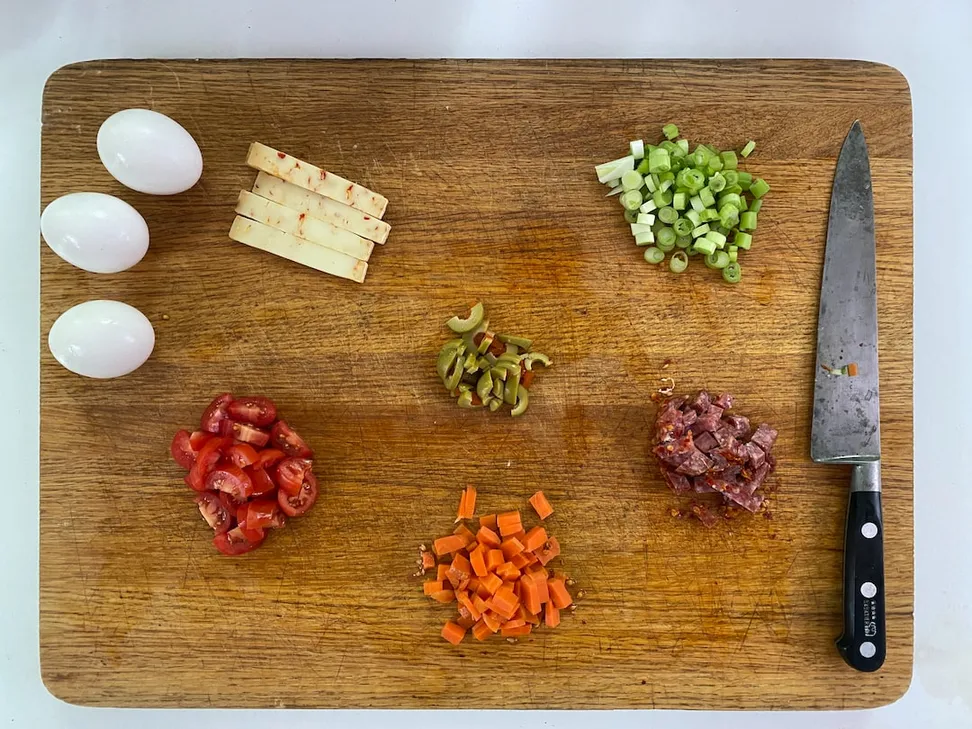A kitchen knife is common in most homes, and its uses vary. However, one question that often arises is, can a kitchen knife cut through bone?
The answer isn’t simple, as it depends on a few factors, such as the type of kitchen knife, the thickness of the bone, and the user’s skill. In this article, we will discuss the various considerations and provide some tips for safely using a kitchen knife to cut through bone.
Can A Kitchen Knife Cut Through Bone?
A kitchen knife is typically made from softer steel than a tactical or hunting knife. This means it is not as hard or strong as a tactical or hunting knife and will not hold an edge either. However, a kitchen knife can still be used to cut through bone if put to the right use.
For instance, a kitchen knife can cut through soft bones like chickens, fish, or rabbits. However, using a kitchen knife to cut through hard bones like those found in beef or pork is not recommended.
This is because a kitchen knife is not strong or hard enough to penetrate through these bones. Additionally, kitchen knives are not designed to be used as weapons, so using them as such could lead to serious injury or even death.
When cutting through bone with a kitchen knife, it is important to use the right technique. The knife should be firmly and straight, with the blade pressed against the bone.
It is important not to see the bone but to use steady and even pressure to cut through it. Additionally, it is important to use caution when cutting through bone with a kitchen knife, as it could slip or break if too much pressure is applied.
So, even though a kitchen knife can cut through bone, it is not recommended. Kitchen knives are not designed to be used as weapons and should not be used as such.
Additionally, using the right technique when cutting through bone with a kitchen knife is important, as it could slip or break if too much pressure is applied. The best way to ensure that a kitchen knife is used safely is to follow the manufacturer’s instructions and always use caution when handling a knife.

Types Of Kitchen Knives
To begin with, it is important to understand that there are different types of kitchen knives. Some are designed for general-purpose cutting and slicing, while others are designed for specific tasks such as boning or filleting. Generally speaking, a good kitchen knife can cut through most bones, but it may require more effort than it would cut through softer materials such as vegetables and fruits.
There are several types of kitchen knives, each with a specific purpose. Here are some of the most common ones you’ll find in a kitchen:
- Chef’s knife: This versatile knife is the go-to for most kitchen tasks, from chopping vegetables to slicing meat. Its broad blade usually curves upward towards the tip, allowing for a rocking motion when cutting.
- Paring knife: This smaller knife is perfect for tasks that require precision, such as peeling fruits and vegetables, trimming meat, or deveining shrimp.
- Bread knife: With its serrated edge, this knife is ideal for cutting through crusty bread without squishing it.
- Utility knife: This all-purpose knife is smaller than a chef’s knife but larger than a paring knife, making it great for tasks that require a little more heft than a paring knife can provide.
- Santoku knife: This Japanese-style knife is similar to a chef’s knife but has a straighter edge and a flatter blade, making it ideal for slicing, dicing, and chopping.
- Cleaver: This heavy-duty knife is designed for chopping through bones and tough cuts of meat.
- Steak knife: These serrated knives cut through cooked meat at the table.
Different knives are designed for different tasks, so it’s important to choose the right one for the job.
Santoku Knife
Santoku knives are a great option for cutting through bone in the kitchen. These knives are typically made from high-carbon stainless steel and have a sharp, long blade for precision cutting. They have a wide blade and a curved edge, which makes them great for chopping, slicing, and dicing meats, vegetables, and even bone. The curved edge helps to cut through bone with minimal effort easily.
Santoku knives also have a dimpled blade, which helps to reduce the friction between the blade and the bone, making the cutting process smoother and easier. Additionally, they have a slim handle, allowing for a comfortable grip and better control when cutting. Furthermore, Santoku knives are extremely durable and can hold an edge for a long, making them a great choice for cutting through bone.
Boning Knife
A boning knife is a must-have tool in any kitchen. It is specially designed to cut through the bones of meat and fish, making it an incredibly useful tool for any home chef. The boning knife’s long, slim blade allows it to get between the joints of meat and fish, allowing for precise and delicate cutting.
The boning knife is usually made from high-quality stainless steel, as this material can hold an edge for a long time and is resistant to corrosion. Many boning knives have curved blades, making cutting curved or rounded bones easier. The blade can also be curved in the opposite direction, allowing for easier cutting in tight spots.
When cutting through bones with a boning knife, taking it slow and using a sawing motion is important. It is also important to ensure that the blade is not inserted too far into the bone, as this can cause the blade to break or bend. Protecting your hands from the blade is important by wearing protective gloves when cutting.
Chef’s Knife
The most important tool you need is a chef’s knife when cutting through bone. A chef’s knife is a multi-purpose knife essential for any kitchen. It is typically made from stainless steel and is designed to be durable and sharp. The blade is long and wide enough to make cutting through bone easier. It is also designed with a curved tip and a sharp edge, making it easier to cut through the bone.
Chef’s knives come in various shapes and sizes, so choosing the one that best suits your needs are important. A good chef’s knife should have a comfortable handle, making it easier to grip and handle while cutting. The blade should also be wide enough to cut through the bone without damaging it. Additionally, the blade should be sharp enough to ensure a clean and precise cut.

Butcher Knife
Many butcher knives are designed to be able to cut through bone. The blade of a butcher knife is usually thicker than a regular kitchen knife and is made of a hard material such as stainless steel or carbon steel. This makes it much more durable and able to handle tougher tasks like cutting through bone. The shape of the blade is also important as it allows for more control when cutting through tougher material.
If you are looking for a butcher knife designed to cut through bone, you will want to look for one with a curved blade. This allows for more cutting precision, as the curves help distribute the pressure evenly. You may also want to look for a serrated knife, which helps grip the bone and make cutting easier.
When using a butcher knife to cut through bone, it is important to be extra careful as the blade can easily slip and cause injury. Hold the knife firmly and use even, steady strokes when cutting. It is also important to wear protective gloves, as the blade will be sharp and can easily cause cuts and injuries.
Electric Knife That Cuts Through Bone
A high-quality kitchen knife with a sharp, pointed blade can cut through bone. However, if you want to cut through bone more quickly and easily, you should invest in an electric knife designed for cutting through bone.
Electric knives are much more powerful than traditional kitchen knives, capable of slicing through bone with minimal effort. The blades of electric knives are made from high-grade stainless steel and are extremely sharp. The blades are also designed to be long and narrow, which makes them perfect for slicing through bone. Electric knives also have a powerful motor that allows them to cut through bone quickly and evenly.
When using an electric knife to cut through bone, it is important to use the proper technique. First, you should ensure the blade is sharp and in good condition. You should also ensure the bone is properly positioned so you can easily cut through it. Finally, you should use a gentle sawing motion to cut the bone evenly and without splintering.
When using an electric knife to cut through bone, it is always important to use caution. The blades of electric knives are incredibly sharp, and they can cause serious injury if handled improperly. You should also wear protective clothing such as gloves, goggles, and a face mask to protect yourself from debris generated as you cut through the bone.
Different Types Of Bones And Their Cutting Difficulties
When it comes to cutting through bone, it depends on the type of bone and the quality of the knife. Bones can be classified into two main categories: hard and soft.
- Hard bones, such as those found in the legs of mammals, are much more difficult to cut through and require a much sharper knife than soft bones.
- Soft bones, such as those found in a chicken’s wings, are much easier to cut through than hard bones. Soft bones are much thinner than hard bones, so a standard kitchen knife should easily cut through them.
Generally, the sharper the knife, the easier it is to cut through bone. However, even a sharp kitchen knife may struggle to cut through thick bone. The thickness of the bone, the blade’s angle, and the knife’s sharpness are all factors that can affect the difficulty of cutting through bone.
The angle of the blade is important for cutting through hard bone. The best angle for cutting hard bones is a narrow angle, as this will provide more pressure on the cutting surface. The blade may struggle to penetrate the bone if the angle is too wide.
The angle of the blade is also less important when cutting through soft bones. However, the knife’s sharpness is still important, as the blade needs to be sharp enough to penetrate the soft tissue.
Factors To Consider When Choosing A Knife
Many people are curious whether a kitchen knife can do the job when cutting through bone. The answer is yes, but there are a few factors to consider before using a kitchen knife to cut through bone.
- The type of knife you use is important. A high-quality kitchen knife, such as a chef’s knife, is likely the best choice for cutting through bone. It is essential to ensure that the blade is sharp enough and that the knife is made from a durable and strong material, such as stainless steel.
- The size of the blade is also important. A kitchen knife with a longer blade will provide more leverage and make it easier to cut through bone. However, a longer blade can also be more dangerous and require more skill. Therefore, it is important to consider the size of the blade when selecting a kitchen knife for cutting through bone.
- It is also important to consider how the knife is held when cutting through bone. A more secure grip is required for cutting through bone, as opposed to a softer grip which is more suitable for slicing vegetables. Using a knife with a comfortable handle will help ensure you have a secure grip.
- The blade should be sharpened before attempting to cut through bone. A dull blade will struggle to penetrate the bone and is far more likely to slip or chip, causing injury. It is essential to ensure that the sharpening stone is high quality and that the blade is sharpened correctly.

Advantages And Disadvantages Of Cutting Through Bone
Can a kitchen knife cut through bone? This is a common question among home cooks and professional chefs alike. Understanding the advantages and disadvantages of cutting through bone is important when deciding whether or not to use a kitchen knife.
The primary advantage of using a kitchen knife to cut through bone is that it can be done quickly and easily. A sharp kitchen knife can easily cut through thin bones like those found in poultry or fish. Additionally, kitchen knives can cut larger pieces of meat and bones, such as those found in beef and pork. This makes it an ideal tool for preparing meals that require various cuts of meat.
However, there are some disadvantages to using a kitchen knife to cut through bone. For example, kitchen knives are not designed to cut through thicker bones like those found in larger animals, such as cows and pigs. Additionally, there is a risk of the knife slipping and causing injury if not properly handled.
Finally, kitchen knives are not designed to handle the force required to cut through thick bones, so they can easily become dull or damaged.
Best Knife For Cutting Through Bone
The best knife for cutting through bone is a cleaver, which is a large, heavy-duty knife with a thick, rectangular blade. It is designed to easily split bones and other tough materials like leather, plastic, and metal.
When using a cleaver, it is important to be careful as the blade can be very sharp. When chopping bones, it is best to use a cutting board to protect the blade and the surface you are putting on. Additionally, the knife should always be used in an up-and-down motion rather than a sideways motion, as this will help to reduce the risk of the blade slipping or breaking.
In addition to a cleaver, another useful tool for cutting through bone is a boning knife. These knives are designed to remove meat from bones easily and can be used to separate ribs and joint bones and even chop through bone. Boning knives usually have a thin, curved blade that helps to maneuver around the bone and remove the meat.
It is important to remember that when using either a cleaver or a boning knife, the blade should always be sharp. Dull knives can be dangerous to use, as they may slip or break when trying to cut through a bone. It is also important to use the right technique when cutting. A sawing motion is best, as this will help to protect the blade and reduce the risk of accidents.
Common Mistakes People Make When Cutting Through Bone
Cutting through bone can be challenging, but it is essential for preparing certain cuts of meat or fish. Here are some common mistakes people make when cutting through bone:
- Using a dull knife: A dull knife can make the process harder and more dangerous. Make sure to sharpen your knife before attempting to cut through bone.
- Not using the right knife: Different types of bones require different knives. For example, a cleaver is good for larger, thicker bones, while a boning knife works well for smaller, more delicate bones.
- Cutting through the joint: Cutting through the joint instead of the bone can make the process easier and yield better results. Look for the joint where the bone meets the meat and start cutting there.
- Applying too much pressure: Applying too much pressure can damage the bone and cause injury to yourself. Instead, gently and steadily work through the bone using a back-and-forth sawing motion.
- Rushing the process: Cutting through the bone requires patience and precision. Take your time and make careful, deliberate cuts to get the best results.
Necessary Safety Precautions For Cutting Through Bone
When cutting through bone, it is important to understand the necessary safety precautions. Kitchen knives are designed for slicing and cutting soft foods, not bones. Cutting through bone with a kitchen knife can be dangerous and should only be done cautiously. Here are some necessary safety precautions to consider:
- Ensure you use a sharp and appropriate blade for cutting through bone. A dull blade could cause splinters or even slip, resulting in an injury.
- Wear protective gloves and eyewear to protect your hands and eyes from flying bone fragments.
- Secure the bone properly before cutting it to prevent movement or slipping, which can result in losing control of the blade.
- Use a cutting board with a non-slip surface and ensure stability before starting the process.
- Take reasonable care when handling the blade and apply consistent cutting pressure to ensure accuracy and enhance safety.
- Be aware of your surroundings and ensure no one is in your working area to prevent unintentional injuries.
Following these safety precautions can cut through bone more effectively and safely. Remember, it is better to be safe than sorry.
Best Practices For Storing And Maintaining Kitchen Knives
Proper storage and maintenance of kitchen knives are crucial for their longevity and performance. Additionally, when in use, kitchen knives should be handled with care to prevent potential injuries. Here are some best practices to follow:
1. Store knives in a knife block, magnetic strip, or sheath to protect them from damage and keep them organized.
2. Keep knives in a designated spot, away from other utensils and tools, to avoid accidental damage or injury.
3. Clean knives with soap and water after each use, and dry them thoroughly with a towel to prevent rust and corrosion.
4. Sharpen knives regularly with a sharpening stone, honing rod, or an electric sharpener. A sharp knife is safer and more efficient to use.
5. Avoid cutting on hard surfaces like marble or glass, which can damage the blade’s edge. Instead, use a wooden, plastic, or bamboo cutting board.
6. Never put knives in the dishwasher or leave them soaking in water, which can damage the handle and corrode the blade.
Conclusion
In conclusion, a kitchen knife can cut through bone; however, it is not ideal. The kitchen knife blade may not be strong enough and sharp enough to cut through bone cleanly, and the process could be difficult and time-consuming.
A cleaver or a saw-toothed knife designed for cutting through bones is recommended. Additionally, caution should be taken when attempting to cut through bone with a kitchen knife, as the knife may become dulled, and the process could be dangerous.
Frequently Asked Questions:
Which knife can cut through bone?
A boning knife can cut through bone.
Can you cut bones with a knife?
No, attempting to cut bones with a knife is not recommended. The bone is usually too hard for a knife to cut through and can damage the knife. It is best to use a saw designed for cutting bones instead.
What is the best tool to cut through bone?
The best tool to cut through bone is a bone saw. Bone saws are specially designed with sharp, narrow blades that easily cut through bones without damaging surrounding tissue.
Can a serrated knife cut bone?
Yes, a serrated knife can be used to cut bone. However, it is not ideal for this purpose, as the saw-like teeth of the serrated blade can easily become dull from the hard bone material. Using a more specialized bone-cutting knife or a hacksaw for this task is best.
What is the best type of kitchen knife for cutting through bone?
The best type of kitchen knife for cutting through bone is a cleaver. Cleavers are designed with thick, strong blades that can handle the tough task of cutting through bone.
Is it safe to use a kitchen knife to cut through bone?
No, using a kitchen knife to cut through bone is unsafe. Kitchen knives are not designed to withstand the stress of cutting through bone, and attempting to do so may cause the knife to break or even cause injury. Using a butcher knife or a cleaver is recommended when cutting through bone.
How do you sharpen a kitchen knife to cut through bone?
To sharpen a kitchen knife to cut through bone, you should use a whetstone to sharpen the blade. Start by soaking the whetstone in water for 10-15 minutes. Lay the whetstone on a flat surface, and hold the blade at a 10-20 degree angle to the stone. Using long, even strokes, sharpen the blade in a back-and-forth motion. Continue sharpening this way until the blade is sharp enough to cut through bone.
What other tools can be used to cut through bone?
Other tools that can be used to cut through bone include saws, chisels, hatchets, cleavers, and bone shears.
